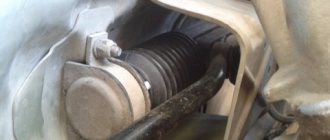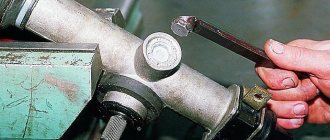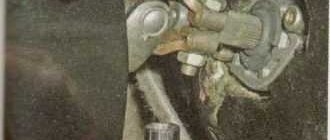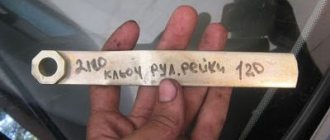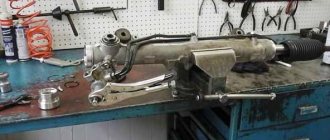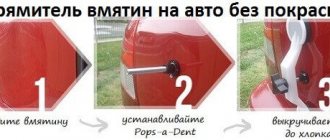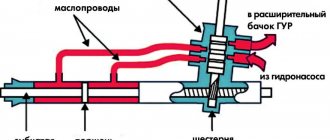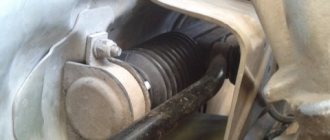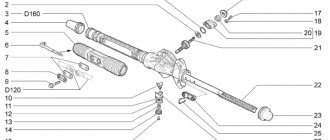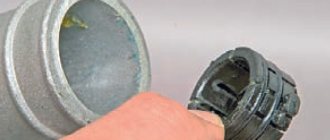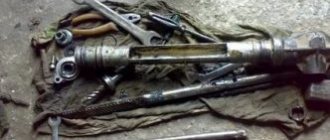Print this article Font size 16
For some reason, many car owners believe that independently adjusting the steering rack on a VAZ 2110 is an impossible and impossible task. This opinion is erroneous, since it is not so difficult to do such work with your own hands. You don't have to be a professional.
If characteristic knocking of the steering rack was noticed on the “tens”, it is recommended to tighten it. Today we will tell you about two effective methods. Which one to choose is up to you to decide.
How to tighten the steering rack on a Priora
VAZ 2170 Priora is a modern Russian-made car.
Like most modern cars, Priora is equipped with power steering. This, of course, makes driving a car much easier, making the steering smoother and lighter, and the car more maneuverable. It would seem that this mechanism has only advantages. Yes, that's practically true. But even here there was a small fly in the ointment. The Priora power steering has a key part that is vulnerable to the unevenness of our roads - the steering rack or, in automotive parlance, the “power steering gearbox”. It supplies force from the steering wheel to the drive wheels. This steering part is located between the steering propeller shaft and the steering rods.
The first sign that the steering rack needs to be tightened is the appearance of a knocking sound while driving over small uneven surfaces. You can hear it very well if you drive along a country road. Irregularities will hit the steering wheel and be transmitted into the driver’s hands, while being reflected throughout the car. In addition, when the steering rack adjustment nut is loosened on the highway, the car will have to be “caught” a little, that is, steered with the steering wheel. This will also become immediately noticeable.
Repair, price
A lift is a fairly simple and quick way, but often it is only a partial, temporary solution to the problem. After all, the appearance of play can be caused by various reasons - the boot may be damaged, gaskets may leak and who knows what else, that is, there is a high probability that the steering rack is running dry. In this case, there is a risk that a short time after tightening it may simply jam. Therefore, troubleshooting the rack will be very useful, at least an external inspection, it will make sure that the anthers and corrugated casing are not damaged.
If you suspect the need for repairs, consider whether you can handle it yourself. Get ready for the fact that you will have to spend the whole day in interesting positions, and you will also need an assistant to perform some operations. Do you know how to install the rack so that the steering wheel is level? If not, you risk having to do the installation again.
An alternative is a service station. They will charge you around 3,500 rubles for repairs, 200 rubles and another 200 will be spent on anthers and so on.
How to tighten the steering rack
Of course you can. In fact, this process will not take you much time. And it does not require any special expertise, so there is no need to go to the service center for this.
In order to tighten the steering rack on a Priora, you will need:
- this article is a guide;
- special key for adjusting the rack to 17;
- inspection hole or overpass;
- flat blade screwdriver;
- key to 13.
It is recommended to perform this work with an assistant. Even a child or a girl can be used as it.
How to get to the adjusting nut
- Disconnect the battery terminals and remove it.
- Using a 13mm wrench, unscrew the bolt securing the battery stand and also remove it.
- From the inspection hole, look under the steering rack itself for the rubber plug of the adjustment mechanism. Pull it out with a flathead screwdriver.
Now you have access to a nut for adjusting the thermal clearance of the steering rack. Using a special key for adjusting the rack by 17, which can be purchased at any auto store, you need to tighten it so that the knocking noise disappears. In this case, you need to carefully monitor so that additional friction sounds do not appear and the steering does not become difficult to move.
The nut should be tightened no more than 25-30 o. Otherwise, when turning sharply, the steering wheel may “bite”. Therefore, ask an assistant to rotate the steering wheel, while you listen to the sounds from the steering rack. If the knocking noise disappears and no additional sounds appear, then the work is done correctly and you can install the rubber plug and battery in their places.
Source
A little theory: front suspension design
Before attempting to fix any problem, there is a tendency to look at the blueprints or repair manual. It is known that the VAZ-2192 parts catalog contains the following object:
This is what the steering rack looks like in the drawing
Whether the knock will remain in the steering rack of Kalina-2 depends on the following: how accurately element “14” is adjusted. The adjusting nut, marked “14”, looks almost invisible here. But first impressions are deceiving. In the catalog, by the way, the element is called “Stop Nut”.
It is important to know that the thrust nut has external threads. And it spins clockwise. And the words “tighten the rack” mean screwing in the specified nut, and nothing more.
Now let's move on to practice and see what the node in question looks like in reality:
If you remove the rail, it looks like this
The nut has a non-standard notch, and it can only be rotated with a special tool. By the way, the recess will be closed with a cap. In the catalog it is designated by the number “15”, and now, let’s look at the appearance of the special key:
Rack adjustment key
The thrust nut is turned at small angles. We are talking about values of 10-15 degrees. What happens if you overdo it with tightening the rack? The knocking noise will disappear, but the steering wheel will turn with difficulty. Therefore, if necessary, the nut can be pulled back.
About the rake
The steering mechanism on Lada cars, starting with model 2108, has a steering rack. It is designed to move steering rods along a horizontal plane, which helps turn the car's wheels.
The design of the slats is quite simple and reliable, with the exception of one small drawback - a plastic bushing.
This bushing is made by the manufacturer from low-quality plastic, which soon leads to play in the rasp in it and the appearance of an unpleasant knock when moving on paving stones.
There is a rail between the engine and the passenger compartment, perpendicular to the exhaust manifold and attached with two brackets to the engine shield.
Design
Steering rack design: 1 – shaft boot, 2 – cover mounting bolts, 3 – Belleville washer, 4 – worm shaft oil seal, 5 – worm gear cover, 6 – sealing collar, 7 – thrust bearing, 8 – worm shaft with bearing, 9 – rasp, 10 – left boot, 11 – binoculars, 12 – binocular bracket, 13 – nut plug, 14 – thrust nut, 15 – thrust spring, 16 – locking collar, 17 – thrust piston collar, 18 – thrust rasp piston, 19 – piston liner, 20 – steering rod bolt, 21 – stopper, 22 – plate, 23 – plastic clamp, 24 – steering rack boot, 25 – left side boot, 26 – steering rack pipe.
Removing the steering column
If after adjustment the problem with the rack does not disappear, you will have to disassemble and repair it. But to do this it needs to be removed. There are two methods of dismantling: with and without tie rods. The latter method is preferable as it requires much less time. Before removing the steering rack on a VAZ-2110, the front part of the car needs to be jacked up on both sides. This is necessary in order to unload the traction.
In the cabin, in the area of the pedal block, you need to unscrew the steering shaft cardan bolt. After this, we go to the engine compartment and unscrew the 2 bolts securing the rods, having previously bent the locking plate. Then you need to unscrew the 4 bolts securing the steering column to the car body. When this is done, remove the column and remove it through the opening of the left wheel arch.
Signs of play in slats
When driving over small irregularities such as a gravel road, shocks and knocks in the suspension are clearly audible and are transmitted to the steering wheel. These signs will not always refer to play in the rack. Similar impacts to the steering wheel can occur due to broken steering ends or a broken crosspiece of the steering mechanism. Before you begin repairing the rack, you must exclude the tips and steering cross from suspicion.
- Impacts to the steering wheel when driving over bumps
- Creaking sound when turning the steering wheel
- Biting the steering wheel in different positions
- The steering wheel does not return to zero position
Checking for play
Checking for play is done by rocking the swing arms up and down. To do this, we find the steering rods under the hood and pull each of them up and down; there should be no play or knocking. If any, then the rack should be maintained.
How the control system works in Kalina
In the model of the domestic automobile industry we are considering today, the steering rack, if disassembled from a technical point of view, is a mechanism that structurally looks like a gear, which in turn is installed on a shaft and is associated with special rods and a rack. Thanks to these elements, the car turns when moving the steering wheel in a certain direction allows the front wheels to move in the same direction.
Modern cars have 3 variations of the rack and pinion mechanism:
- Electric steering mechanism;
- Hydraulic modern mechanism;
- Mechanical mechanism.
So, the car control system is an electric drive. This is what helps reduce the load on the driver. In this case, the increase in turning force is carried out due to a special electric motor built into the column, so to speak. This device is used exclusively on premium and, accordingly, luxury cars. For example, in our Lada Kalina, the electric mechanism can be obtained as an additional option for an additional payment for the TOP configuration.
The next option is a hydraulic mechanism. Viburnums of the first and second generation are equipped with this mechanism. Owners of such cars receive sharpness and lightness of the steering wheel. And not only Russian cars, but also many modern foreign models are equipped with the popular and most convenient hydraulic drive.
The mechanical mechanism is the simplest in its design and is also found on many machines. In this case, as you understand, the rods will be turned only through the use of the driver’s physical force. It is clear that such a car is extremely difficult to drive.
In addition to the above mechanisms, there is also a mixed version - electrohydromechanical. It combines all the best qualities of an electric and hydraulic amplifier. You can find it on the Kalina Sport model.
Let us note that each of the systems we have listed has its own advantages, and to some extent disadvantages, but they all break down with the same frequency. If a breakdown of a mechanical control rack will lead to insignificant costs for repair work, then electrical and hydraulic breakdowns will force you to spend a fair amount of money on repairs. It follows that it would be nice to know how to tighten the steering rack on the car we are considering with your own hands.
Lift
If knocking is detected in the steering wheel, it can be tightened, but tightening will be effective only if there is knocking from the worm gear. If the knocking noise comes from a broken plastic bushing, then tightening is useless.
As is known from practice, the worm mechanism is quite reliable and is very rarely the culprit of knocking. Most often the bushing is to blame.
You can determine the culprit of the knock by pulling the steering rods one by one.
- If there is a knocking sound when applying forces to the right link, then the bushing is to blame.
- If there is a knocking sound when you apply force to the left linkage, then the worm gear is to blame.
In the first case, a lift is not advisable. Since the tightening nut only tightens the worm mechanism. To eliminate the knocking noise, it is necessary to remove the steering rack from the car and have it repaired.
Repair kit
In a Priora with an EUR, a rack from Kalina was installed with catalog number 11183-3400010 20. Therefore, the repair kit must be purchased specifically from Kalina.
Steering rack number
The repair kit includes a large number of parts necessary for repairs.
The price of a new rack starts from 5,000 rubles and higher, depending on the manufacturer, but new does not mean good, and the cost of a repair kit varies from 500 to 1,000 rubles, which is almost 10 times cheaper than a new rack.
How to tighten the steering rack on a Priora: tips and instructions, nuances with ESD and power steering, videos on the work
Lada Priora is a Russian-made car that is highly popular among our compatriots due to its low price and attractive appearance. However, even despite this, the Lada Priora has one vulnerability associated with the poor quality of the road surface - the steering rack or, in the language of specialists, the “power steering/power steering gearbox”. Fortunately, you can tighten it with your own hands.
When does the steering rack need to be tightened on a Priora?
The steering rack is a vulnerable point for Lada Priora
The first sign indicating the need to adjust the rack is the appearance of a knocking sound when driving over small uneven surfaces. The knocking will be felt especially clearly when driving on country roads. In this case, the driver will feel shocks and vibrations on the steering wheel, which will also be transmitted to the entire car body.
In addition, if the steering wheel adjustment nut is loosened when driving on the highway, the car will “float” a little, and additional steering will be required from the driver, which will also immediately become noticeable.
Experts also say that a tightening is necessary if the driver begins to notice the appearance of a clearly audible crunching sound in the area of the steering column, as well as an increase in the amplitude of the steering wheel rotation.
When tightening doesn’t help and the mechanism needs to be changed
It’s worth thinking about replacing the rack when tightening it does not in any way affect the car’s behavior on the road, and also does not help get rid of the unpleasant knocking noise. A failed steering rack will cause significant play in the steering wheel. Moreover, it may begin to jam (this happens extremely rarely, but similar cases are known). If the rack begins to jam, then it is better to stop using the car, as this can lead to the most dire consequences.
You cannot do without a replacement even if after tightening it you managed to get rid of knocks and vibrations, but they reappeared later.
What is needed for work and how to tighten the steering
To tighten the steering rack you will need special wrenches
To perform the tightening you will need the following tools:
- Slotted screwdriver (in simple terms, a “flat” screwdriver);
- Wrench 13;
- A special 17mm wrench designed to adjust the steering rack.
To make the work more comfortable and faster, it is recommended to drive the car into a special inspection hole or overpass, and also use an assistant, whose role even a child can handle.
The lower rack fastening nut is not easy to unscrew
To get to the rail, you should perform a number of simple steps:
- Disconnect the battery terminals and dismantle it;
- Using a 13mm wrench, unscrew the bolt securing the battery stand, and then remove it;
- Directly under the steering rack, using a slotted screwdriver, you need to pull out the small plug of the adjustment system.
Tips for use
A complete replacement and repair is a series of actions, for the implementation of which you need to have not only special knowledge, but also a considerable amount of free time, so if the car owner does not have either the first or the second, it is preferable to go to the nearest service station.
It is better to entrust steering rack repair to service station specialists
At the same time, in order not to become their regular guest, you should know some secrets for operating the steering rack, which can significantly extend its service life.
- We strongly do not recommend “jumping” your car on curbs, or driving at high speed on rails, since each such trip causes cracks to appear on the rack itself, as well as deformation of the shaft that is part of the steering mechanism.
- It is not recommended to frequently turn the steering wheel all the way. Of course, in this case it will be very difficult to demonstrate your maneuvering capabilities, but this will significantly increase the life of one of the most important parts of the machine.
- Carefully monitor the condition of the protective anthers, which must maintain their tightness. Replacing anthers is several times cheaper than replacing the entire rack.
- It is also worth monitoring the level and condition of the hydraulic fluid, since its decrease or change in color is associated with problems in the vehicle’s hydraulic system, which can result in rack failure.
From time to time you need to undergo a full maintenance, which will allow you to eliminate faults in advance, which can cause irreversible consequences, injury to yourself, your loved ones and other road users. And also, if problems are detected in the operation of the car, it is better not to take risks and go to the nearest car service center as quickly as possible.
Key for tightening the Priora steering rack
In general, I read a lot about the steering rack here and decided to check mine. He opened the hood and began to move the rod, a knock was clearly heard in his hand. I went to the store and bought a ten-size key for the steering rack.
Without removing anything, I easily stuck my hand into this nut and began to twist it.
The key turned 45° without much effort, I also tightened it 25-30° with some effort. I checked the traction rods again, there was no knocking, I immediately went to check, there were no knocking sounds, at the railway crossing too. But! The steering wheel began to turn tighter. Tell me, won’t this harm the EUR mechanism in any way? I just think this is a temporary solution, I will sort out the rack, but a little later. It was simply impossible to drive at all.
To tighten the steering rack you will need special wrenches
To perform the tightening you will need the following tools:
- Slotted screwdriver (in simple terms, a “flat” screwdriver);
- Wrench 13;
- A special 17mm wrench designed to adjust the steering rack.
To make the work more comfortable and faster, it is recommended to drive the car into a special inspection hole or overpass, and also use an assistant, whose role even a child can handle.
The lower rack fastening nut is not easy to unscrew
To get to the rail, you should perform a number of simple steps:
- Disconnect the battery terminals and dismantle it;
- Using a 13mm wrench, unscrew the bolt securing the battery stand, and then remove it;
- Directly under the steering rack, using a slotted screwdriver, you need to pull out the small plug of the adjustment system.
After this, you will have access to the nut responsible for adjusting the thermal gap in the rail.
Next, you need to put your hand under the steering rack and try to put the rack wrench on the nut. It is necessary to tighten the nut clockwise, but since the rack itself is located upside down, from the outside it may seem that the nut must be tightened counterclockwise. Experts recommend tightening the nut no more than 25–30 degrees at a time, after which you should try to rotate the steering wheel, which should turn without jerking or biting.
It is also necessary to listen to the sounds coming from the steering wheel - if there are no knocks when turning the steering wheel, and there are no other noises, then the rack is tightened correctly, and you can put the battery and rubber plug in their place.
How to tighten the steering rack
Before we begin describing this repair, if it can be called such at all, let's look at the main reason why you have to tighten the steering rack on a Priora.
So, I think that many owners know that when a knock appears from the steering rack or its rod, it is necessary to make an adjustment, or rather, tighten the rack using a special nut, which is located on the inside of the case, which is clearly visible in the photo below.
To understand where this nut is located, look at the photo below, everything is shown from above - from the hood side, of course, in this case this nut is located on the reverse side:
To get to this adjusting nut, you will most likely have to remove the battery, since without it there is more free space under the hood. Although the good news is that even the battery in the Priora does not interfere with this repair (unlike cars such as Kalina or Granta).
It is worth noting that you may need the following tools for work:
- 10mm wrench or socket wrench
- key for 13
- the key for tightening the rack is exactly 2110 and not 2108
Now, using a special key from the inside, as shown in the photo below, insert it into the hole:
Making adjustments yourself
You can access the adjusting nut from the engine compartment, but to do this you will need to remove the battery, as well as the battery mounting pad. It is better to drive the car into a pit and then remove the crankcase protection (engine mudguard). If you look from under the bottom, the required element is immediately visible:
You need to turn this nut
And when you open the hood, you can feel the nut, but not see it. Its location is marked in the figure:
To make adjustments, place the key here
Before adjustment, remove the rubber cap from the recess. Its appearance is shown in the photo:
Remove the cap and install the key
If it is not entirely clear what exactly needs to be done, it is better to contact the service. The key is installed in the recess and then rotated 10-15 degrees.
When looking at the rack from above, turning the key clockwise corresponds to unscrewing it. The handle of the key comes from the center of the car - which means tightening is being done. By the way, the latter is true provided that the handle faces forward.
Adjusting the VAZ-2112 steering rack: photos and videos, useful tips
There is an opinion among VAZ-2112 owners that the steering rack is very difficult to adjust, and sometimes only needs to be replaced. We absolutely tell you that this is not so!
The video shows the process of adjusting the steering rack on the front-wheel drive family of VAZ 2110-2112 cars.
Easily!
Thanks to the design of the car, any car enthusiast can easily remove and adjust or adjust the steering rack on the spot, because you just need to carefully read our instructions.
Causes of steering rack malfunction
If while driving, often on uneven roads, you find that all the vibrations are transmitted quite strongly to the steering wheel, then most likely the steering rack needs to be adjusted.
How to carry out this work in two different ways is written below.
Tighten the steering rack
Before you begin tightening the steering rack, you need to prepare a special wrench, which is made in the shape of an octagon with a diameter of “17”.
If you have such a key, tightening the rack can be done without difficulty.
And for the best access to the rail, it would not be amiss to have an inspection hole or a lift.
Step-by-step work order
- First of all, lift the hood and pay attention to the free space under the master cylinder.
- Next, take a flat-head screwdriver, as well as a flashlight or carrying lamp for the best visual access.
Everything is ready for work
We get to the steering rack nut from the rear of the subframe and follow the steering rack body to the part where it intersects with the steering shaft. This adjusting nut is located nearby.
The arrow indicates the location of the adjusting nut.
- Please note that most inexperienced car enthusiasts confuse a nut with a plug . A distinctive feature of the nut is the thick layer of dirt that is located on its body and its octagonal shape .
- Since the nut is closed from the factory with a special plug, it will be almost impossible to make adjustments without dismantling it. And in order to remove it from the seat, use a flat screwdriver, prying it off the edge of the base.
- Once it is removed, take the key you prepared earlier and insert it into the base of the nut.
Although visibility is minimal, it is possible to make a replacement. - Next, slowly move clockwise, turning the key 15-20 degrees, tighten it until the backlash disappears.
- Flat blade screwdriver.
- Hammer.
- Key or heads for “10”, “13”, “15”, “17”, “19”, “27”.
- Pliers.
- Special wrench for tightening the steering rack.
Please note that you should not tighten it all the way!
Diagnostics of rack tightening
You can diagnose the degree of tightening in the following way.
Turn the steering rack first in one direction, then in the other direction with sharp movements. And if during such manipulations no extraneous sounds arise, this will mean that the rail is tightened and in good condition.
After carrying out such work, you can reassemble everything in the reverse order, first of all this concerns the engine crankcase protection.
Tightening the steering rack on a removed mechanism
Before you start working, you need to prepare the tool:
When the tool is assembled, you can start working.
Removing the unscrewed rail
In order to remove the rack now, it is necessary to free it from the rotary arms to which the tie rod ends are attached.
- Having a “19” key on hand, loosen, but do not unscrew the nut that secures the ball pin.
By disconnecting the cotter pin, the bolt will easily come out of its place of fixation.
In this case, it is possible to apply light blows to its body. When it is removed, you can easily unscrew the tip completely.
This will allow us to maintain the approximate wheel alignment angle when assembling it.
- When the tips are dismantled, nothing will stop us from getting the entire rail from its place.
The process of adjusting the steering rack on a VAZ-2112
- Adjustment of the steering rack should be carried out with the device clamped in a vice . This is necessary so that it remains motionless in this state, and if necessary, bars are placed on its edges.
So, the nut will tighten easily.
Please note that there are two types of steering racks, with and without power steering.
Installation of the steering mechanism
- Before installing the rack, make sure that all connections are secure and that the adjusting nut is capped.
- Then inspect the condition of the steering tips; if their diagnostics reveals any play, they must be replaced with new ones.
- Otherwise, we install the steering rack in the same order as removal.
If you follow our instructions exactly, all work can be completed in the shortest possible time and without additional costs.
Instructions for adjusting the rack
- Drive onto an overpass/pit or use a lift.
- Remove the engine protection, then use a flathead screwdriver. Don't forget to provide the car with good lighting.
- Find the rear component of the subframe, which is located behind the steering rack. At this point, the shaft and rack should alternate. There is also an adjusting nut there. The latter is similar to the plug of the adjusting nut, so it is important not to confuse it. This is a common mistake among beginners.
- If the steering gear was previously untouched, the nut will have a green plug. It functions as a stopper and is installed at the factory.
- Remove the plug with a flat screwdriver. It may break, but there is nothing terrible here.
- Take the adjusting key, having first removed the stopper, and tighten it in a clockwise direction. You cannot press it all the way. The degree of clamping directly affects the strength of knocks during movement.
- Turn the wrench 10 degrees and check the rack for play. It is worth pressing again if it is present. Rotating more than 15 degrees at a time is not recommended.
- Check the clamping level. You need to take the rail, turning it with a sharp movement in one direction and then the other. The rack is tightened efficiently, if no extraneous noise is observed.
- There is no point in putting the stopper in place. If you keep it safe, it is of no use.
While removing the rack of your VAZ-2110 car, you can perform other work, for example, examine the condition of the units and components. Something may need to be tightened or replaced.
